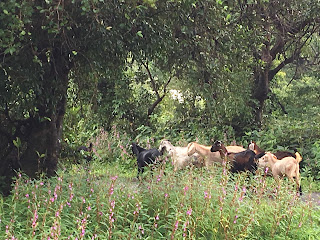Sustainable Farming - Know your Soil
 |
| Healthy, Fertile Soil |
 |
| Infertile Soil |
It is natural for a common man to question the authenticity of “Organic food” available in the markets today. In fact, I would insist, one must.
Knowing, what makes your food organic; will empower you to make the right
choices.
Sun, Soil, Water and Air make the food for everybody. Each plays a pivotal and specific role in food
production. It is a good idea to start with the Soil.
Soil is made of minerals, air, water and organic
matter-biomass from trees and living organisms. It takes around 200 years for
formation of 1 cm of soil and 3000 years for it to have enough components to
make it fertile. This should put the questions about the “Organic quality of
soil” in perspective for us. A soil is either fertile or it’s a deserted land
without any bioactivity.
For beginners it is necessary to know about soil carbon,
this enables growth. Plants get all the carbon, hydrogen, and oxygen they need
from carbon dioxide
and water, which they use to build carbohydrates during photosynthesis. To
build other kinds of molecules they also need elements like nitrogen,
phosphorous, and sulfur. Plants get these
as well as other elements from the soil.
A farmer has to
focus on increasing the soil carbon, target being 1 (currently its dropped to
0.4% which is pointing to desertification of the soil).
Majority of the soil
carbon is in topsoil, which is the humus. A biotic soil is moist and has a
texture like tea powder. Moisture in soil indicates its capacity to retain water,
hence higher the soil carbon, more is the absorption of water, less run off,
increased water table. Having living life in the form of trees, bushes,
grasses, vines, wild animals, birds and micro organisms to decompose the
same is indicator of a complete soil circuit in the land.
A farm, when it has
all the necessary components of a sustainable ecosystem; suitable
microclimatic conditions; the microorganisms thrive and make
the soil. When you see hectors of organic farm land with just crops , you know its not standing on a balanced ecosystem.
In a desire to EAT
HEALTHY FOOD by causing less damage to the environment, many farming
methodologies took shape in past 30 years.
Organic/Natural/Biodynamic/Permaculture/Zero Budget/Vedic etc. to name a few.
Based on the beliefs and resources people adapted to one that fits into their scheme
of things.
The Organic farming
community can loosely be classified into 5 groups.
- Conventional farmers who have been practicing agriculture as main source of livelihood for 4 generations or more.
- First generation farmers, practicing sustainable farming for past 30 plus years
- New breed of farmers, who treat organic farming as business.
- New breed of farmers wanting to do organic farming because they want to follow a healthy and sustainable lifestyle.
- Corporate Farmers, who do organic farming for exports and volume business.
Each group, treats their soil differently. It depends on forest cover, carbon
sequestration, cropping pattern, tilling methods, water harvesting, use of
indigenous seeds, livestock and nature of organic inputs given to soil.
First group, which
has moved away from chemical input intensive farming to chemical free farming,
(green revolution started post world war II, so its nearly 60 plus years of
onslaught) has double task of removing the chemical residue from the soil and
water. Build humus and carbon content back in the soil.
The first generation
farmers who started off sustainably, followed the path of building an ecosystem
first and farmed as a part of it. Their soil is healthier, no doubt.
3rd group
looks at production rather then productivity and hops from one method to
another , then focusing on ecosystem and soil. This is an Impatient lot.
4th group
has potential and will contribute to better carbon sequestration then food for
masses.
5th group
is going the same dooms way by extracting more and more from the soil by giving
more and more top organic inputs. No emphasis on plantation, soil carbon and ecosystem.
What you EAT comes
directly from the soil, like the nutrition, flavor, aroma and taste.
So when you buy
Organic Produce, see whose farm the product is coming from, and make that
important choice!
Be empowered.



Comments
Post a Comment